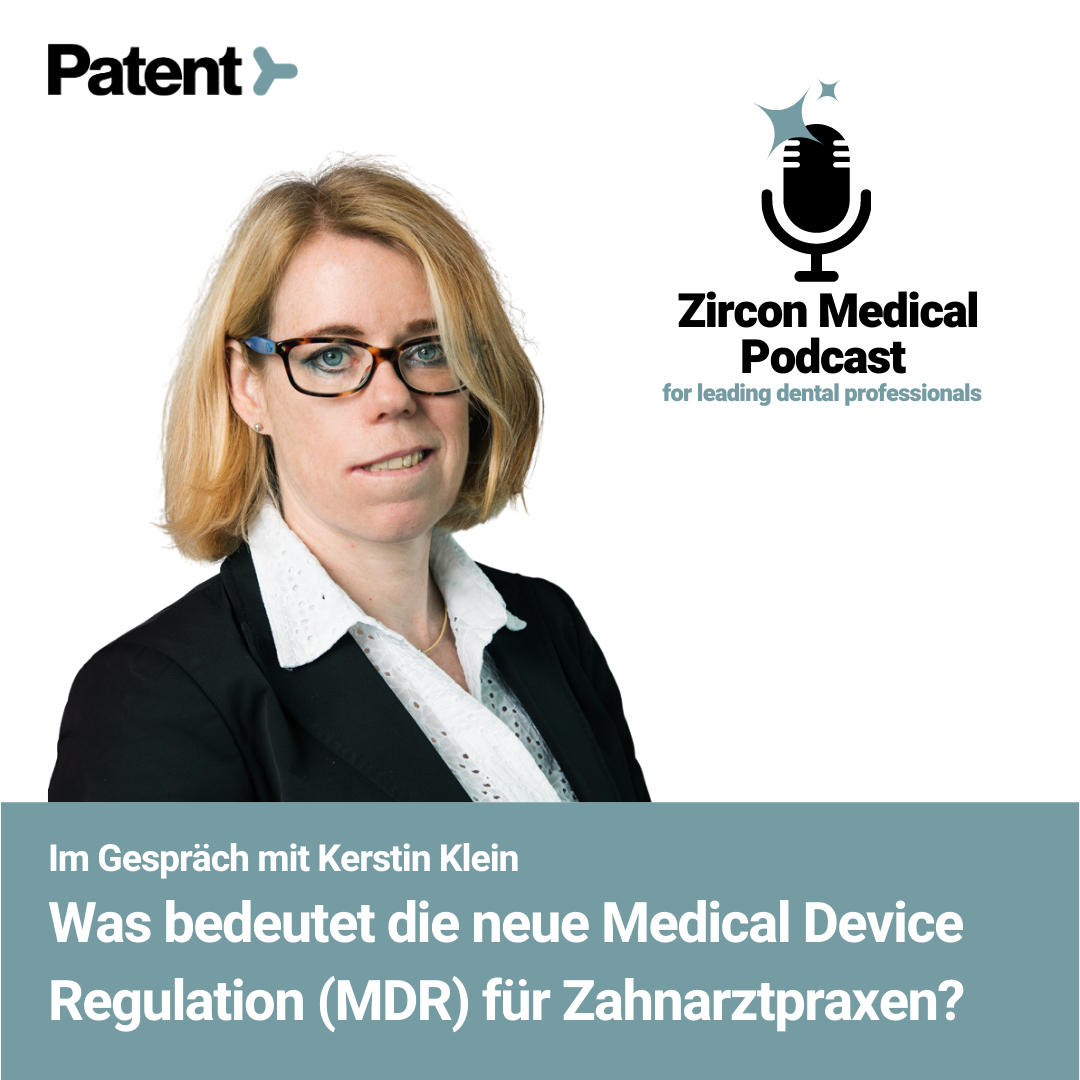Ms. Kerstin Klein
CEO at iMDPC GmbH
Specialist and consultant for medical device approval..
Website: www.imdpc-klein.com
Email: info@imdpc-klein.com
Phone: +49 173 426 2096
Am Freizeitzentrum 23, 78194 Immendingen / Deutschland
In Conversation with Ms. Kerstin Klein
The Medical Device Regulation (MDR) is a new set of regulations governing the production and distribution of medical devices in Europe. The MDR was published on the 25th of May, 2017, but its date of application is set for the 26th of May, 2021. That means, starting from the 26th of May, 2021, all new medical devices will have to meet the requirements of the new MDR to be placed in the European Market. But what does that mean for the products used by physicians and practices currently?
Luckily for us, Ms. Kerstin Klein, the CEO at iMDPC GmbH, has the answers because she specializes in medical device approval, planning, and realization. She recently joined us on our Zircon Medical podcast to discuss the new MDR law and its implications.
Introducing Ms. Kerstin Klein, the CEO at iMDPC GmbH
Ms. Kerstin Klein is a specialist and consultant for medical device approval, planning, and realization. She’s the CEO at iMDPC (International Medical Device & Packaging Consult) GmbH, an organization that provides consultation services on packaging medical devices, especially in the area of "sterile packaging.”
Having grown up in the medical technology sector, specifically in the area of quality management and regulatory affairs, Ms. Klein has an all-encompassing understanding of the medical device industry. Her husband once led a company that packaged sterile and non-sterile medical products, so the decision to collectively establish iMDPC GmbH seemed naturally synergistic.
Ms. Kerstin Klein uses her experience with regulatory affairs to provide evidence for the safety of medical products. She also aims to give patients the assurance that their physicians use safe and certified products, setting a course for high standards of treatment.
An introduction to the new MDR (Medical Device Regulation) law
The MDR (Medical Device Regulation) comes into force on the 26th of May, 2021. It was initially supposed to be enacted a year earlier, but the date was pushed ahead by a year due to the ongoing COVID-19 outbreak. Ms. Klein states that the new MDR has significant implications for the manufacturers of medical devices and the practices using those devices.
Manufacturers must now adhere to far stricter regulations to demonstrate the safety and performance of their medical devices — achieving a CE-certification is far more difficult. As for the practices, it gives practicing dentists the necessary assurance that the CE-certified medical device really corresponds to the highest standards because the criteria for approval have now been set incredibly high.
The pieces of the puzzle leading up to the MDR
While there’s no single “trigger” for the MDR, Ms. Klein states that the new MDR law is foregrounded by the infamous PIP breast implants scandal and partial investigations by journalists.
The PIP scandal is one of the most well-known cases of medical device misuse in Europe. Launched in 1991, PIP (Poly Implant Prothese) was a company that specialized in producing silicone breast implants. The company was authorized to produce medical-grade silicone implants in 1997, but it soon turned out that they had been using unapproved, industrial-grade silicone in their implants.
PIP’s legal troubles started in 2003, prompted by an incredibly high rate of ruptures, inflammation, and other long-term complications. The legal struggles eventually culminated in the founder’s (Jean-Claude Mas) arrest and subsequent imprisonment in 2013. Mas, the founder, was sent to prison for four years, fined 75,000 euros, and banned for life from working in medical services.
While the specter of the scandal certainly looms large, Ms. Klein believes that’s just one piece of the puzzle leading up to the MDR. The new regulations were also prompted by investigations from journalists that revealed that notified bodies had allowed themselves to be bribed or that certificates had been issued without the necessary due diligence.
The MDR (Medical Device Regulation) was formulated and published on the 25th of May, 2017, a few years after the PIP scandal grabbed headlines.
The medical devices are separated into different risk categories
The new MDR law pertains to a wide range of medical devices, instruments, and tools, even ones that seem relatively mundane. While all medical devices and equipment must meet certain regulations, they’re separated into various risk categories based on their long-term potentialities. Mouth mirrors, for example, belong to an entirely different regulatory category than implants.
Mouth mirrors are categorized as “low risk” medical devices. Milling cutters would be classified in the “medium risk” category, and an implant or x-ray equipment would be categorized in the “high risk” category. In case of implants because it remains in the patient’s body for long periods and has more potential for damage if insufficiently evaluated.
Identifying CE certification in medical devices
Ms. Klein compares the CE-certification to the TÜV approval for cars in Germany. If you drive a car without TÜV approval, you’re essentially using it illegally. Similarly, if you use a medical device without CE-certification, you’re using a product that lacks a legal basis for sale. The CE certification basically ensures that the product meets certain safety requirements established by the European Union.
Identifying the CE certification is easy because it’s clearly marked on the product’s label or the packaging. The CE marking must contain a four-digit numerical code that identifies the notified body that’s taken care of the certification. If there’s any doubt about the certification, the dentist can request a declaration of conformity for further assurance. Most manufacturers publish the CE certificate on their websites.
Registration in the EUDAMED database
The CE certification is now necessary to get registered in the EUDAMED (European database of Medical Devices). As such, the EUDAMED database will now store the CE certificate, address, and other essential data regarding all medical devices. Evidence regarding the medical products’ overall safety and results will be tracked in the centralized database with regular safety reports to highlight the product’s overall quality. The reports allow dentists and other medical providers to compare different products’ safety ratings and choose the ideal manufacturer.
The medical device’s safety record is tracked proportionally based on the number of products sold and the proportion of reported errors. If a patient using a dental implant experienced nerve damage, that would be reported to the authorities and included in the database, eventually becoming a part of the product’s safety report. If a particular dental implant has high failure rates due to insufficient osseointegration, that would also become a part of the safety report.
In the current system, each European country has its own database in its national language. Besides the language differences, different countries also follow different standards. For example, the Austrian database doesn’t publish these reports at all. The lack of transparency and differences in languages currently make comparison incredibly challenging. But the centralized EUDAMED database will significantly improve transparency and accessibility, allowing physicians to compare standardized data from all European countries.
The positive and negative long-term consequences of the MDR
Positive Consequence
Manufacturers with safe products will stand out prominently in the market because of the uniformity of the requirements for medical devices. The manufacturer will only receive a certification if they meet all the regulations and standards.
Negative Consequence
Small companies will struggle to meet all the requirements because they involve higher costs. As such, they might be adversely affected by the MDR. However, that shouldn’t be a major problem for bigger or established companies.
Tips for dentists to make their practices MDR complaint
Ensure you have CE-marked products, and ask the sales team to highlight the CE label where necessary.
Focus on "single-use products" or "sterile-packaged products” because the requirements for reusable products are enormous. The product must display accurate and precise information on what it can be used for, how often, and when it must be disposed of. In the near future, manufacturers are likely to move to single-use products and sterile products to avoid the logistical efforts associated with reusable products.
Ms. Klein aims to help her customers prepare for MDR and successfully get through the certification audits, enabling them to bring their safe medical devices to the customers. You can learn more about Ms. Klein and her company iMDPC GmbH from their official website www.imdpc-klein.com. You can also listen to her in our Zircon Medical podcast or continue reading for a detailed exploration of the new MDR law.
Register for our free newsletter.
Never miss one of our weekly episodes with leading dental professionals.
Understanding the Medical Device Regulation (MDR)
An independent article by the Zircon Medical Team
The Medical Device Regulation (MDR) is a new set of regulations governing the production and distribution of medical devices in Europe. Manufacturers who want to sell medical devices in the European marketplace must comply with the regulation and its standards. The MDR was officially published on the 25th of May, 2017, and set to be implemented in the spring of 2020. However, due to the COVID-19 pandemic, the date of application was postponed by a year, from the 26th of May, 2020, to the 26th of May, 2021.
This article answers some of the most frequently asked questions about MDR and its implications.
When do medical device manufacturers need to comply with the new MDR?
The MDR’s current date of application is the 26th of May, 2021. From that date, all new medical devices will have to meet the requirements of the new MDR to be placed in the European marketplace.
What about medical devices certified by the European Notified Body under the Medical Device Directive or the Active Implantable Medical Devices Directive?
Medical devices certified by the European Notified Body under the Medical Device Directive (93/42/EEC) or the Active Implantable Medical Devices Directive (90/385/EEC) will have until the 26th of May 2024 to fulfill the new requirements and become MDR-compliant.
Why did the MDD need to be updated?
Numerous reasons and factors contributed to the replacement of MDD with the MDR. The MDD (Medical Devices Directive) was enforced in 1992 when the concept of software as a medical device (SaMD) didn’t exist, and there weren’t any apps for patients to monitor their own health. Demographics have shifted considerably since 1992, with the younger population increasingly pushing for transparency in the technical and safety reports of medical devices. Those are just two of the many factors involved in the formulation of the MDR.
What are the major changes in the MDR?
The definition of “medical devices” will now also include products and devices that don’t have intended medical purposes, i.e., devices meant for aesthetic use, such as d
Medical devices will now be reclassified according to their risks, contact duration with the patient, and invasiveness. As such, implantable devices (like dental implants) and other class III products will have stronger scrutiny processes.
Class III and implantable devices will need more rigorous clinical investigations to pass the safety and performance standards.
Manufacturers will need to produce stronger documentation to pass the MDR standards.
The “person responsible for regulatory compliance” will have to be identified.
Unique device identification will be used to improve traceability and recall.
The Notified Bodies will implement more rigorous surveillance to reduce the risks of unsafe medical devices.
The Notified Bodies will also come under greater scrutiny to ensure transparency.
All existing medical devices and active implantable devices will have to be re-certified according to the MDR standards within the stipulated timeframe.
All incidents with the dental products must be reported to the public database (EUDAMED), giving everyone unlimited access to the data.
Which devices are covered under the MDR?
According to the MDR, a medical device is an “instrument, apparatus, appliance, software, implant, reagent, material, or other article” used to:
Diagnose, prevent, monitor, relieve, or treat injuries, disabilities, or diseases.
Modify, replace, or investigate pathological, physiological, or anatomical processes.
Provide or collect data via the examination of samples derived from the human body.
Clean, sterilize, or disinfect other medical devices.
Support or control contraception through metabolic, pharmacological, or immunological means.
Provide aesthetic results, such as dermal fillers, laser for skin resurfacing, colored contacts, etc.
How does the MDR enforce more traceability?
The MDR enforces Unique Device Identification (UDI) to ensure complete traceability for all medical devices in the European marketplace. Each device will carry a device identifier (DI), and each production series will carry a production identifier (PI), ensuring complete traceability at every stage.
Furthermore, the EUDAMED (European database of Medical Devices) will be a part of a database system with accurate and updated information on each device’s performance, safety standards, and reports of incidents. The EUDAMED database will be accessible to everyone, including the Notified Bodies, medical device companies, physicians and practices, and consumers.
Where can I find more information on MDR?
We’ve compiled answers to some of the most frequently asked questions about the new MDR law. However, for a comprehensive overview of the new regulations and their implications, please explore the following sources:












